Childish Gambino's 'This Is America' Video, Explained
Childish Gambino took the internet by storm this weekend with the release of his new single “This Is America” and its accompanying music video steeped in haunting images of black oppression and gun violence.
Fans unpacked the subtle references on Twitter, with many proclaiming the rapper, whose real name is Donald Glover, as one of the most important voices of this generation.
ICYMI, below are some of the most-talked-about references in “This Is America,” in order of appearance in the video.
Calvin The Second
Viewers initially confused actor and musician Calvin The Second, who plays the guitarist in the video’s opening shot, for the father of Trayvon Martin, the unarmed black teenager shot to death in Florida in 2012 by George Zimmerman.
Calvin The Second confirmed his appearance in the video Sunday on Instagram: “Got the call from one of my agents while up at Coachella that they wanted me for the shoot on Sunday, drove down and got to be a part of history.”
Warehouse
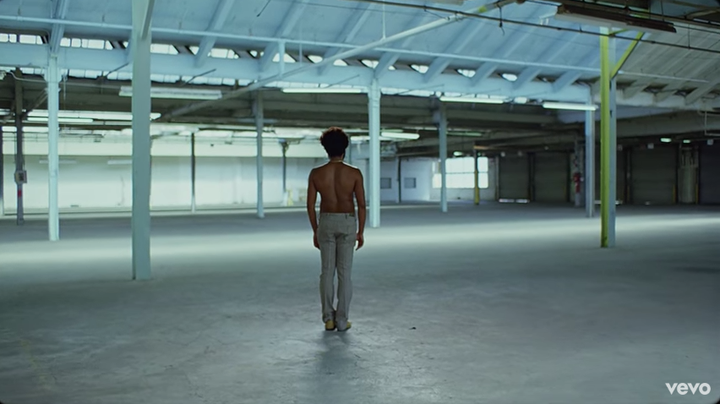
“This Is America” is set entirely in a drab warehouse, which some viewers interpreted as the country’s foundation, built on systemic white supremacy and oppression.
“Much of this seems to take place in a building/warehouse where the foundation and support systems (the beams) are mostly white,” tweeted @JarridGreen.
Some veteran Childish Gambino fans pointed out similarities to his 2011 “Freaks and Geeks” music video, which also takes place in a warehouse.
Fela Kuti
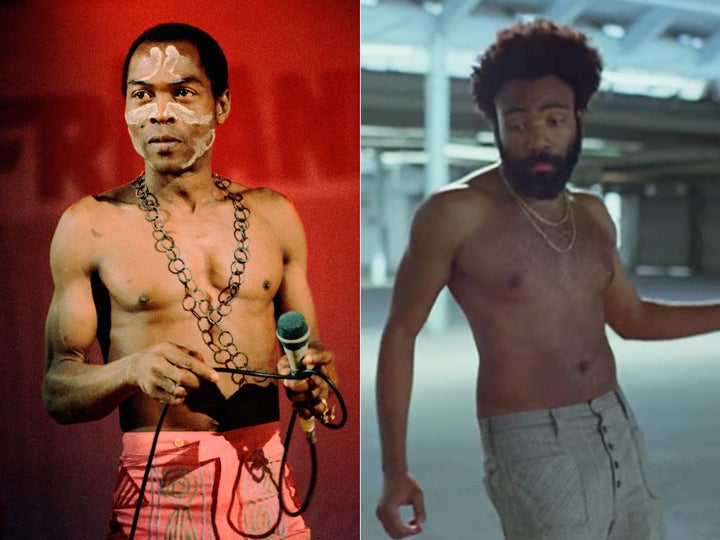
The video features a shirtless Childish Gambino donning a gold chain necklace and trousers that give off a ’70s vibe. His look appears to be inspired by the late Fela Kuti, a Nigerian musician dubbed “Africa’s answer to Handel” by one arts critic.
“Fela Kuti reverberates in Childish Gambino’s body,” civil rights activist Michael Skolnik wrote of the video on Twitter. “It is art at its highest form. Still in awe.”
African dance
Fans were obsessed with Childish Gambino’s nod to African dances, including Shoki and Gwara Gwara, a style of dance popularized in South Africa (and featured in Rihanna’s 2018 Grammys performance).
“Childish Gambino reeks of talent,” tweeted @muchman16. “I loved the part where those kids danced shoki and gwara gwara.”
Others pointed out how dance trends can distract from the life-or-death situations affecting black communities.
“Childish Gambino’s #ThisIsAmerica spoke to me as a black South African women,” tweeted @Cpaw2. “Women being hunted and killed while society does the gwara gwara.”
Jim Crow
Shook by how fast I caught this reference. I haven’t seen a Jim Crow picture in years. Donald Glover did not come to play with y’all today. #ThisIsAmericapic.twitter.com/5Xq4tLSJ7P
— Nick (@nicky_furiosa) May 6, 2018
Justin Simien, the filmmaker behind “Dear White People,” tweeted a “love letter” to the video on Sunday, breaking down its searing use of Jim Crow imagery.
“Jim Crow began as one of the first fits of white American culture to address it’s former African slaves (and their descendants) at all,” Simien wrote. “A minstrelsy mainstay played by white men in black face, and sometimes by black men in black face.”
“Jim Crow began as mere pop culture entertainment at the expense of America’s freed slaves and became the means of their oppression,” he continued, noting that the character’s name was eventually lent to laws enforcing racial segregation in the U.S.
America’s gun obsession
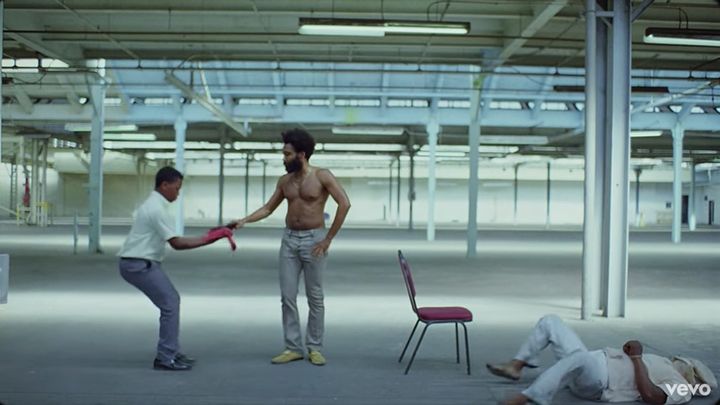
Each time Childish Gambino fires a gun in “This Is America,” he hands it off to someone who whisks it away in a red cloth. Viewers interpreted these scenes as Americans willingness to protect gun rights over people, despite the country’s alarmingly high rates of gun violence.
“Because this is America,” tweeted @Shugah. “We shoot up schools, churches, each other and then we place the guns tenderly in a cloth to protect them. And then we dance.”
Suicide
No one caught the fact that at 2:13, a man jumps to his death. It shows how we don’t care about suicide in America, yet are all in when it’s a dance/trend. This Is America. #thisisamerica@donaldgloverpic.twitter.com/OXhFMUjX6V
— iris (@siriouslyyy) May 7, 2018
One viewer suggested the apparent suicide scene points to a pervasive mental illness stigma plaguing the African-American community.
“Does the man jumping to his death that goes largely unnoticed because of Gambino’s dancing serve as a reminder that suicide & poor mental health in the African American community is being ignored,” asked @JuelzKojoey on Twitter.
Charleston massacre

One of the most disturbing scenes in “This Is America” features an all-black church choir getting shot up with an assault-style rifle. The massacre appears to be a reference to the 2015 mass shooting at a church in Charleston, South Carolina, in which a white gunman killed nine black churchgoers.
“Childish Gambino really made a reference to the Charleston church shooting that happened in 2015,” tweeted @EmanThatKid. “He shows how mass shootings are normalized in America, even if you shooting up a place of worship.”
Viral videos of police brutality and racism
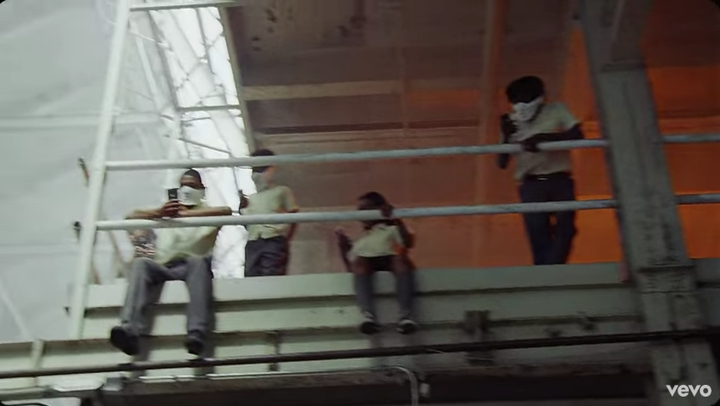
In one scene, black teenagers use their phones to record the chaos unfolding below as their mouths appear to be covered by a white material.
Some viewers believed this to be a reference to the rise of viral videos of police brutality and racist encounters to overcome the metaphorical muzzling of black people in a white supremacist system.
“Kids are seen recording everything on their phones, referencing the use of livestreams in police shootings as a means of documenting and sharing the truth,” tweeted @thelocalemo. “Gambino’s lyrics state, ‘this is a celly, that’s a tool.’”
White horse
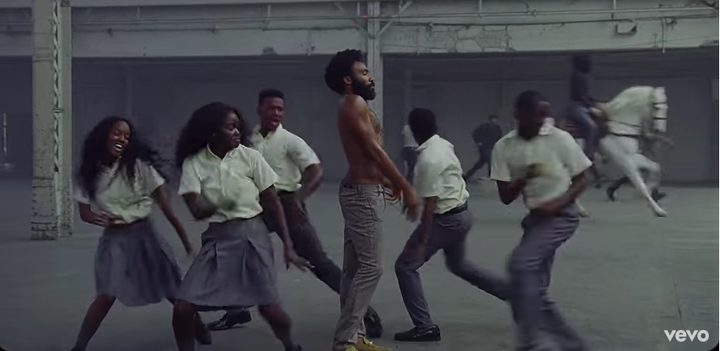
It’s easy to miss the white stallion galloping by in the background on the first viewing of “This Is America.” Upon closer look, viewers pointed to biblical references of a “pale horse” heralding the apocalypse, which largely goes unnoticed by the characters dancing in the foreground of the video.
Karen Civil, a social media and marketing guru, pointed out the specific passage from the Bible’s Book of Revelation: “And I looked, and behold a pale horse: and his name that sat on him was Death, and Hell followed with him.”
Traffic stop killings
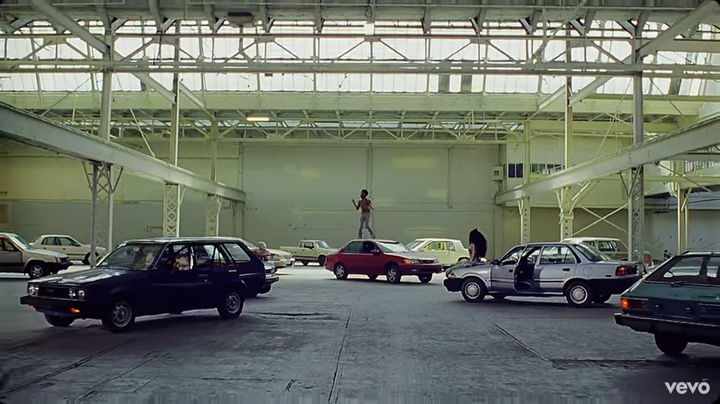
Toward the end of the video, Childish Gambino dances atop a red car surrounded by other decades-old cars with their hazard lights flashing and doors open.
Viewers drew connections to the black men routinely killed by police during traffic stops, including Philando Castille in Minnesota in 2016.
“Do a lot of those cars … have their drivers side doors open and hazards on cause they’re symbolic of the cars of all the people pulled over and killed by the police?” wondered Twitter user @giddy_pony.
Others found economic symbolism within the sea of beat-up cars.
“I’m having a 4 am finals procrastination epiphany that the mostly parked, vacant cars in #ThisIsAmerica reference to the stalled socioeconomic and political mobility of Black people in America,” tweeted @izaynab.
SZA
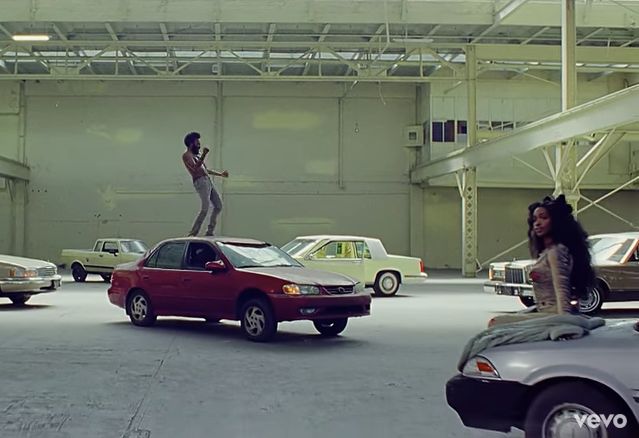
R&B singer SZA made an appearance in “This Is America,” sending her fans in a frenzy. Viewers noted the similarities between her hairstyle and the Statue of Liberty’s crown.
SZA appeared to confirm the Lady Liberty theories Sunday on Instagram.
Liberty .
A post shared by SZA (@sza) on
The Sunken Place
Anyone who has seen the film “Get Out” likely picked up on the eerie vibes at the end of the video as Childish Gambino attempts to escape the warehouse. It reminded many of “the Sunken Place” seen in the 2017 film, the mental space where the main character Chris goes after he’s been brainwashed, unable to control his body.
“The Sunken Place means we’re marginalized,” Jordan Peele, the movie’s director, explained on Twitter in March 2017. “No matter how hard we scream, the system silences us.”
Daniel Kaluuya, who played Chris in “Get Out,” introduced Childish Gambino’s performance of “This Is America” on “Saturday Night Live.”
When you realize you’ve been watching everything from the #Sunkenplace. #ThisIsAmerica#GetOutpic.twitter.com/xgi4AgiXRe
— ivan fernandez (@nfernan87) May 7, 2018
Ad-libs
Twitter user @_mikepearson suggested “This Is America” features over a dozen improvised lines from mostly black artists, including Kendrick Lamar and Offset.
However, Complex pointed out that the streaming music service Tidal only lists Young Thug, 21 Savage, Quavo, Slim Jxmmi and BlocBoy JB as contributors on the song.
#ThisIsAmerica Ad-libs I heard
0:36/2:01/3:01/3:42 – Young Thug
1:08 – Kendrick
1:20/1:36/2:42 – BlocBoy
1:21 – Big Sean
1:26 – Rick Ross
1:39/2:20/2:32 – 21 Savage
1:40 – Lil pump
2:06 – Slim Jxmmi
2:14 – Offset
2:25/2:30/2:44 – Quavo
3:08 – Aminé— mike (@_mikepearson) May 7, 2018
Let’s block ads! (Why?)


